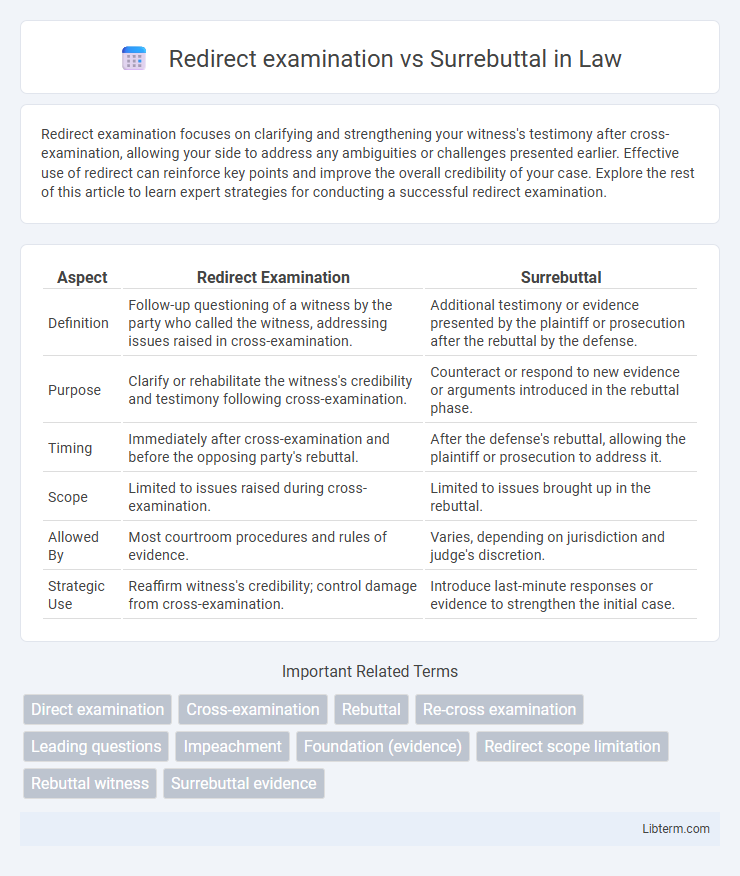Redirect examination focuses on clarifying and strengthening your witness's testimony after cross-examination, allowing your side to address any ambiguities or challenges presented earlier. Effective use of redirect can reinforce key points and improve the overall credibility of your case. Explore the rest of this article to learn expert strategies for conducting a successful redirect examination.
Table of Comparison
| Aspect | Redirect Examination | Surrebuttal |
|---|---|---|
| Definition | Follow-up questioning of a witness by the party who called the witness, addressing issues raised in cross-examination. | Additional testimony or evidence presented by the plaintiff or prosecution after the rebuttal by the defense. |
| Purpose | Clarify or rehabilitate the witness's credibility and testimony following cross-examination. | Counteract or respond to new evidence or arguments introduced in the rebuttal phase. |
| Timing | Immediately after cross-examination and before the opposing party's rebuttal. | After the defense's rebuttal, allowing the plaintiff or prosecution to address it. |
| Scope | Limited to issues raised during cross-examination. | Limited to issues brought up in the rebuttal. |
| Allowed By | Most courtroom procedures and rules of evidence. | Varies, depending on jurisdiction and judge's discretion. |
| Strategic Use | Reaffirm witness's credibility; control damage from cross-examination. | Introduce last-minute responses or evidence to strengthen the initial case. |
Introduction to Redirect Examination and Surrebuttal
Redirect examination allows a party's attorney to clarify or rebut issues raised during cross-examination, enhancing witness credibility and reinforcing key testimony points. Surrebuttal follows rebuttal arguments, providing the opportunity to address new evidence or arguments introduced, ensuring a balanced and complete presentation of the case. Both play crucial roles in trial advocacy by structuring the flow of evidence and testimony.
Definition of Redirect Examination
Redirect examination is a phase in a trial where the attorney who called the witness first questions them again to clarify or rebut issues raised during cross-examination. It aims to reinforce the witness's credibility and address any confusion or attacks on their testimony. Surrebuttal follows, allowing the original party to respond to new evidence introduced in the opposing side's rebuttal.
Definition of Surrebuttal
Surrebuttal is a phase in a trial where the party that presented the initial rebuttal evidence offers a response to the opposing party's rebuttal, aiming to counter or clarify points raised. This stage occurs after redirect examination, which typically involves clarifying or expanding on testimony elicited during cross-examination. Surrebuttal allows for a limited and focused opportunity to address new evidence or arguments introduced in the rebuttal phase, reinforcing the original position or exposing weaknesses in the opposition's case.
Purpose and Objectives of Redirect Examination
Redirect examination aims to clarify and reinforce a witness's testimony following cross-examination, addressing any ambiguities or misunderstandings that may have arisen. Its primary objective is to rehabilitate the witness's credibility and solidify key facts in favor of the examining party. Surrebuttal, on the other hand, is used to counter new evidence or arguments presented during rebuttal, maintaining the balance of proof without rehashing previously covered topics.
Purpose and Objectives of Surrebuttal
Surrebuttal serves to challenge and refute evidence or arguments presented during the initial rebuttal phase in legal trials, ensuring the party has an opportunity to address new information that was not covered in direct examination or cross-examination. The objective of surrebuttal is to clarify facts, reinforce key testimony, and prevent misleading conclusions by providing a final opportunity to respond before the case moves forward. This process helps maintain the integrity and completeness of the evidentiary record for the judge or jury.
Key Differences Between Redirect Examination and Surrebuttal
Redirect examination and surrebuttal serve distinct roles in trial procedures. Redirect examination follows cross-examination, allowing the original party to clarify or counter issues raised, focusing mainly on the witness already presented. Surrebuttal occurs after the rebuttal phase, introducing new evidence or witnesses specifically to challenge points from the opposing side's rebuttal, thus expanding the scope beyond the initial testimony.
Rules and Limitations Governing Redirect Examination
Redirect examination follows cross-examination and aims to clarify or rebut issues raised, limited to the scope of cross-examination questions under Federal Rules of Evidence Rule 611. Lawyers cannot introduce new topics or evidence during redirect; this phase strictly addresses matters discussed on cross-examination to prevent unfair surprise or ambush. Courts enforce strict adherence to these limitations to ensure fairness and maintain the orderly progression of witness testimony.
Rules and Limitations Governing Surrebuttal
Surrebuttal is a limited phase in trial procedure allowing the plaintiff to respond exclusively to new issues or evidence introduced during the defendant's rebuttal, governed by strict rules to prevent reopening broad topics already covered in direct or cross-examination. Courts typically permit surrebuttal only if it directly addresses surprises from rebuttal testimony, ensuring the trial remains focused and efficient while preserving the parties' rights to a fair hearing. Any attempt to introduce entirely new subjects or evidence during surrebuttal is generally disallowed, reinforcing its role as a narrow tool rather than an extension of rebuttal.
Strategic Importance in Legal Proceedings
Redirect examination is strategically important for clarifying or rehabilitating a witness's testimony after cross-examination, ensuring key facts remain credible and less vulnerable to opposing counsel's attacks. Surrebuttal allows a party to respond to new evidence or arguments introduced during rebuttal, maintaining the balance of information and preventing unfair advantage. Effectively using redirect and surrebuttal strengthens a party's case by addressing weaknesses and reinforcing critical points in the litigation process.
Conclusion: Choosing the Appropriate Examination Method
Redirect examination focuses on clarifying or reinforcing testimony after cross-examination, targeting specific issues raised to strengthen a witness's credibility. Surrebuttal allows for answering new evidence or arguments introduced during rebuttal, ensuring a balanced presentation of facts. Choosing the appropriate method depends on whether the objective is to support initial testimony or to address unexpected information raised late in the trial.
Redirect examination Infographic

 libterm.com
libterm.com